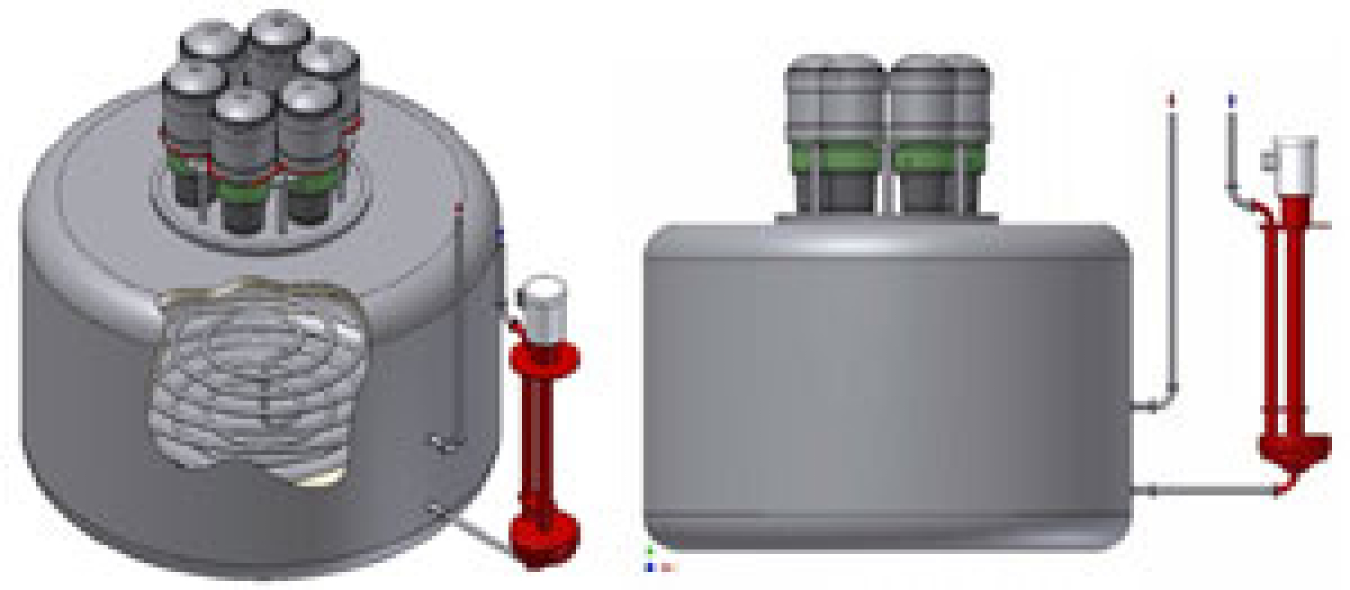-- This project is inactive --
Infinia, under the Baseload CSP FOA, developed and demonstrated a subscale system for baseload CSP power generation using thermal energy storage (TES) in a unique integration of innovative enhancements that improves performance and reduces cost.
Approach
The TES system designed by Infinia is applicable to dish and power tower systems, allowing for high temperature (600° to 800°C), maintenance-free thermal energy storage. This integrated system allows large amounts of energy to be stored cost-effectively and efficiently through the use of phase change salts. The target levelized cost of energy (LCOE) for this dish system is $0.08–$0.09/kWh. LCOE projections for a 30 kW system are being updated in each phase of the project. Infinia identified and organized tasks within each phase to:
- Provide proof of concept by the end of Phase 1 with a 1-hour scale TES lab demonstration unit and preliminary system design;
- Complete system design and demonstrate a Heat Transport System (HTS) on sun by the end of Phase 2; and
- Manufacture, deliver, and test a 75% capacity factor system by the end of Phase 3.

This thermal energy storage system for baseload CSP power generation employs an innovative design to provide a unique integration of thermal salt, heat transfer fluid/device, and Stirling engine that improves performance and reduces system cost.
Innovation
Infinia pioneered the design of a 30-kW, 6-hour molten salt phase change TES system for dish systems with possible application to power towers. In the scale-up from 3 kW to 30 kW, the project used a liquid metal pool boiler to transfer heat from the TES to the engine heater head. This is the primary innovation, resulting in much more dramatic heat transfer rates (10%+ increase) between the TES and the power block. The thermal conductivity enhancement within the salt aimed to be achieved with a future full-scale system based on Infinia's 30-kilowatt (kW) solar dish engine, but the proposed effort focused on component and system development and demonstration at the current commercial 3-kW size. A secondary innovation is the inclusion of a nickel mesh inside the TES medium to improve thermal conductivity (60% increase) as the TES material solidifies and melts (three times faster).
Conclusion
Basic functionality of the concept to integrate thermal energy storage with a pool boiler using low-cost test units was confirmed. The subscale units informed key design features of the larger, lab-scale module, which had a partially successful preliminary demonstration of the technology in late 2012. Initial testing exceeded by 30% the basic Phase 1 objective of 3 kWh for net electricity produced while operating on TES stored energy only, but the output was well below the nominal generator power level. More work is needed to better understand and modify the freezing characteristics of the salt, but the energy density already exceeds that of alternative TES approaches, and the hermetically sealed system is also simpler than any known alternative.
A detailed scoping study of a heat transport system for a dish-mounted solar receiver was conducted, the conclusion of which is that the state-of-the-art for molten salt or liquid metal pumps are limited to temperatures below that which are useful for this concept. However, it has come to light that a tower-mounted TES with heliostat field has significant advantages for this system and should be considered for larger scale designs. A rough LCOE estimate for a 30 kWe, 4 hour design was conducted, resulting in a real levelized cost of electricity of 13.5¢/kWh.
Final Report
Qiu, Songgang. Innovative Phase Change Thermal Energy Storage Solution for Baseload Power. No. DE-EE0003585 Infinia Corporation, 2013. doi:10.2172/1087080.
Publications, Patents, and Awards
- Qiu, Songgang, Ross Galbraith, and Maurice White. "Phase Change Material Thermal Energy Storage System Design and Optimization." ASME 2013 7th International Conference on Energy Sustainability American Society of Mechanical Engineers, 2013. doi:10.1115/ES2013-18335
- White, Maurice, Songgang Qiu, and Ross Galbraith. "Phase Change Salt Thermal Energy Storage for Dish Stirling Solar Power Systems." ASME 2013 7th International Conference on Energy Sustainability collocated with the ASME 2013 Heat Transfer Summer Conference. American Society of Mechanical Engineers, 2013. doi:10.1115/ES2013-18292
- Qiu, Songgang, and Ross Galbraith. "Material compatibility study for thermal energy storage containment structure with phase change material." ASME 2013 International Mechanical Engineering Congress and Exposition. American Society of Mechanical Engineers, 2013. doi:10.1115/IMECE2013-66634
Learn about other concentrating solar power research.
